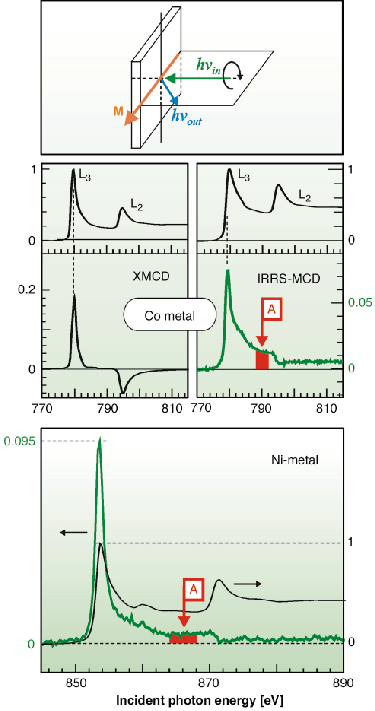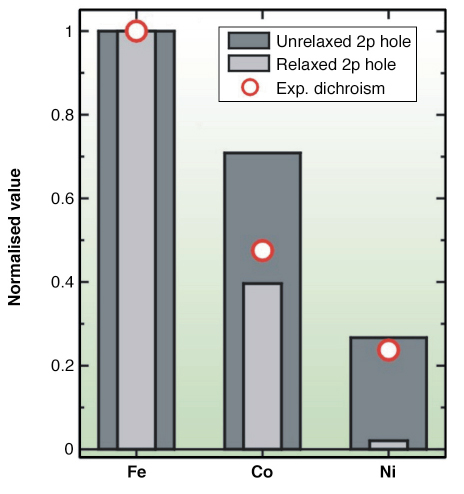- Home
- Users & Science
- Scientific Documentation
- ESRF Highlights
- ESRF Highlights 2005
- X-ray Absorption and Magnetic Scattering
- Femtosecond Dynamics in Ferromagnetic Metals
Femtosecond Dynamics in Ferromagnetic Metals
In electronic Resonant Raman Scattering (RRS) the sample is resonantly excited at a core threshold and a photon is emitted bringing the sample to the final state. This process sets a characteristic time scale connected to the intermediate state core-hole lifetime. If there is an evolution of the system during this time scale the effect is seen in the spectral function [1]. Consequently, this approach to study fast processes is called a core-hole clock experiment. The present work is, to our knowledge, the first implementation of the core-hole clock in the study of magnetism. This is done in the ferromagnetic metals (Fe-Co-Ni) using the scattering channel 2p63dn + h![]() in
in ![]() 2p53dn+1
2p53dn+1 ![]() 2p63dn+13s1 + h
2p63dn+13s1 + h![]() out, where n is the 3d occupation number in the ground state and h
out, where n is the 3d occupation number in the ground state and h![]() in and h
in and h![]() out are the incident and outgoing photon energies (in this case h
out are the incident and outgoing photon energies (in this case h![]() out is about 100 eV lower than h
out is about 100 eV lower than h![]() in). We use the so-called Integrated Resonant Raman Scattering (IRRS) [2] where one measures as a function of h
in). We use the so-called Integrated Resonant Raman Scattering (IRRS) [2] where one measures as a function of h![]() in the integral of the scattered intensity in the scattering channel. The measurements were taken at ID08 with a special instrument built for this purpose. The geometry is shown in the upper panel of Figure 113.
in the integral of the scattered intensity in the scattering channel. The measurements were taken at ID08 with a special instrument built for this purpose. The geometry is shown in the upper panel of Figure 113.
 |
|
Fig. 113: Upper panel: the experimental geometry. Central panels: comparison for Co metal between the absorption XMCD (at the left) and the IRRS (at the right with the IRRS spectrum in black and dichroism in green). Lower panel: IRRS data for Ni metal. |
The magnetic circular dichroism (MCD) spectrum is the difference between spectra measured with left and right circularly polarised X-rays. The IRRS spectra show an effect that is absent in ferromagnetic insulators. A magnetic circular dichroism is seen in IRRS spectra also in those regions between L3 and L2 and above L2 where the absorption XMCD gives no signal (see the central panels for Co in Figure 113 where the red areas show this effect for the IRRS dichroism given in green). This effect is due to the spin dependent screening occurring in the intermediate state [3] so that the core-hole becomes polarised. In order for this to take place, this process requires a non-zero magnetic moment of the system. In the fully relaxed theoretical model of Ref. [3] the dichroism (more exactly the flipping ratio) depends on the local magnetic moment of the excited site once the core-hole is fully screened. The crucial experimental information given here is the trend of this dichroism (flipping ratio) along the sequence Fe-Co-Ni and in particular the observation, shown in the bottom panel of Figure 113, that Ni-metal clearly displays this effect. This is important since in a fully relaxed situation we should not have an effect because a full screening of the core-hole in Ni gives a 3d10 configuration with zero magnetic moment. Thus over the characteristic time scale of the scattering (typically 1-2 femtoseconds) Ni has no time to develop a spin dependent screening of the Fermi gas. More can be seen from Figure 114 where the histograms give the magnetic moments of the relaxed and unrelaxed sites [3] compared to the flipping ratio of the IRRS-MCD given by red circles. The data are normalised to the case of Fe where a relaxed model accounts for the effect as seen in Auger spectroscopy [3].
 |
|
Fig. 114: Comparison between the measured IRRS dichroism (flipping ratio) in the region A (red in Figure 113) and the local magnetic moments with relaxed and unrelaxed 2p hole. The data are normalised to the Fe case. |
The trend shows that Co is somewhere between the fully screened and unscreened situation whereas Ni is basically unrelaxed. Thus Ni is much slower in building up the screening and we attribute this behaviour to the narrow band nature of the Ni 3d holes while the Fe and Co are definitely much more itinerant. In this sense there is a connection between the correlation properties and the magnetic dynamics over short time scales. In conclusion the use of the core-hole clock in soft X-ray resonant scattering reveals a substantially slower dynamics in Ni compared to Fe and Co metal.
References
[1] P.A. Brühwiler, O. Karis and N. Mårtensson, Rev. Mod. Phys. 74, 703-740 (2002) and references quoted therein.
[2] L. Braicovich et al., Phys. Rev. Lett. 90, 117401 (2003).
[3] A. Chassé et al., Phys. Rev B 68, 214402 (2003) and references quoted therein.
Principal publication and Authors
L. Braicovich (a), G. Ghiringhelli (a), A. Tagliaferri (a), G. van der Laan (b), E. Annese (c) and N.B. Brookes (d), Phys. Rev. Lett. 95, 267402 (2005).
(a) INFM-CNR, Dipartimento di Fisica, Politecnico di Milano (Italy)
(b) Magnetic Spectroscopy, Daresbury Laboratory, Warrington (UK)
(c) Dip. Fisica, Università di Modena e Reggio Emilia (Italy)
(d) ESRF



